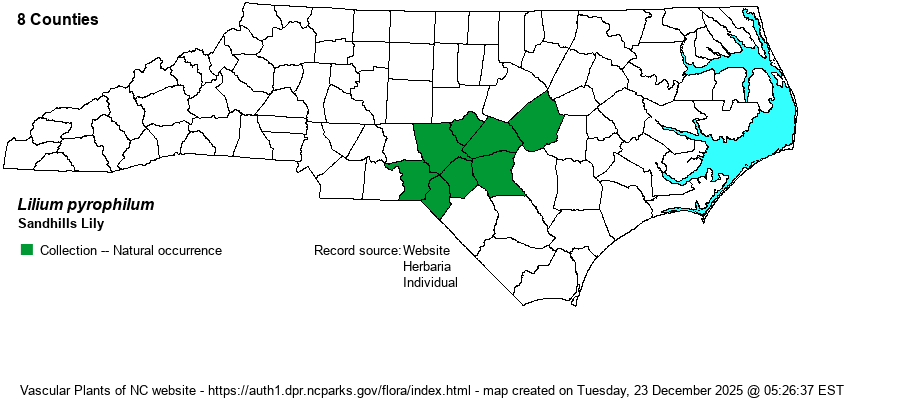| Author | M.W. Skinner & Sorrie | |
| Distribution | Occurs throughout the Sandhills region, extending slightly northeastward to Johnston County, but reports elsewhere are likely of L. superbum (such as northeastward toward the VA state line near the Fall Line).
This species, described only in 2002, has a very small range, primarily in the Sandhills region from southern NC southwestward through central SC and into eastern GA; however, several records from eastern VA extend the range northward. Thus, the overall range is very narrow and barely consists of about 18 counties. | |
| Abundance | Rare to uncommon in the Sandhills. Though there are many records -- over 70 in the NC NHP database, nearly all are just a few individuals, and it seldom if ever grows in large stands (of more than 10-20 individuals). This is a State Endangered species. NatureServe has moved the Global Rank from G2 to now G2G3 owing to VA confirming records from three counties. | |
| Habitat | This lily has a very selective habitat -- open seepage areas, such as in ecotones of streamhead pocosins, and also in powerline clearings where there is permanent seepage. Though it is a fairly tall herbaceous species, it can easily get shaded out by the abundant shrubs and small trees that also grow in its seepage habitats. Frequent bouts of prescribed fire, or frequent mowing of powerlines, are necessary to keep the habitats sunny and open enough for this species to thrive. |
| Phenology | Blooms from late July to mid-August; and fruits about a month or two after flowering. | |
| Identification | This species has some characters of both L. michauxii and L. superbum, each of which grows in the central part of the state and has similar flowers. The plants tend to resemble L. superbum in several ways. L. superbum also grows in wet spots, as does L. pyrophilum, and it has similar leaves but superbum's are more numerous per whorl and attenuate-tipped. This new species grows to about 3-4 feet tall, and occasionally to 5 feet tall. The leaves grow in about 4-10 whorls, with 4-11 narrowly lanceolate, acute leaves in each whorl. The stem contains several large, nodding orange to occasionally red flowers, with the 6 narrow tepals strongly recurved such that the tips at times touch behind the flower. Each flower is about the size of a baseball and is similar to those of L. michauxii and L. superbum, though usually a bit deeper in color. This latter species is taller, more robust, and almost always has 5-22 flowers, and the leaves tend to have downward-arching tips (as opposed to leaves straight or ascending). L. michauxii grows in uplands, and its leaves are obovate (wider above the middle) and generally thick. Though the total number of known individuals in the state is well under 1,000 plants, this is a species that someone who walks enough margins of streamhead pocosins, or powerlines with some slope, can possibly find one or two individuals on his or her own. It blooms in the extreme heat of late July and early August, and you must also be prepared to deal with wet feet, ticks, mosquitoes, and other unpleasant conditions to find this species. | |
| Taxonomic Comments | This species was subsumed -- uncomfortably -- within L. michauxii in RAB (1968), but morphologically it is much closer to L. superbum. Jay Carter, who worked the Sandhills in the latter decades of the last century, were aware of this orange lily that didn't fit comfortably into either L. michauxii or L. superbum. It was first thought to be conspecific with a lily from well south of the Carolinas -- Lilium iridollae -- but that species has mostly golden-yellow flowers and a few other characters that did not quite fit. However, there are tall orange-flowered lilies growing in northeastern NC and southeastern VA that are occasionally treated as L. pyrophilum (as in the SERNEC database) but which are best considered as some form of L. superbum.
| |
| Other Common Name(s) | Sandhills Bog Lily | |
| State Rank | S2 | |
| Global Rank | G2G3 | |
| State Status | E | |
| US Status | | |
| USACE-agcp | OBL link |
| USACE-emp | OBL link |

